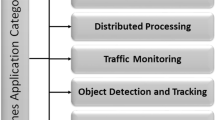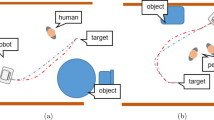Abstract
The fuzzy ant colony optimization (FACO) method proposed in this paper minimizes the iterative learning error of the ant colony optimization (ACO) algorithm using fuzzy control. This algorithm finds the shortest path, detects any obstructions in front of the mobile robot using ultrasonic transducers, and adjusts the turning angle of the mobile robot so as to avoid obstacles. To verify the FACO algorithm, simulations using a mobile robot in two environments were carried out. The first environment was shortest-path planning without obstacles. The second environment was shortest-path planning for a single destination with obstacles. This paper also compares tests carried out in a simple Z-shaped environment map and in a complicated environment map. By comparing FACO with a pattern search (PS) algorithm, a genetic algorithm (GA), particle swarm optimization (PSO), and traditional ACO for the cases in the simple Z-shaped environment map, we found that the path distance obtained using FACO was 2.60, 4.40, 2.04, and 6.53% shorter than that using PS, GA, PSO, and ACO, respectively. In the complex environment map, as compared to the self-adaptive ant colony optimization, FACO had a path distance that was 1.38% shorter. Therefore, the results showed that the FACO algorithm can find the shortest path and avoid obstacles for both simple and complex topographies.














Similar content being viewed by others
References
AlHajri MF, El-Naggar KM, AlRashidi MR, Al-Othman AK (2012) Optimal extraction of solar cell parameters using pattern search. In: Proceedings of 5th international conference on renewable energy, vol 4, pp 238–245. http://dx.doi.org/10.1016/j.renene.2012.01.082
Al-Othman AK, Ahmed NA, AlSharidah ME, AlMekhaizim HA (2013) A hybrid real coded genetic algorithm-pattern search approach for selective harmonic elimination of PWM AC/AC voltage controller. J Electr Power Energy Syst 44:123–133. doi:10.1016/j.ijepes.2012.07.034
Brand M, Masuda M, Wehner N, Yu XH (2010) Ant colony optimization algorithm for robot path planning. In: Proceedings of IEEE on computer design and applications (ICCDA), Qinhuangdao, China, pp V3-436–V3-440
Cheng CB, Mao CP (2007) A modified ant colony system for solving the travelling salesman problem with time windows. Math Comput Model 46:1225–1235. doi:10.1016/j.mcm.2006.11.035
Dorigo M (1992) Optimization, learning and natural algorithms. PhD thesis, Politecnico di Milano, Italy
Dorigo M, Gambardella LM (1997) Ant colony system a cooperative learning approach to the traveling salesman problem. Proc IEEE Transact Evolut Comput 1:53–66. doi:10.1109/4235.585892
Fetanat M, Haghzad S, Shouraki SB (2015) Optimization of dynamic mobile robot path planning based on evolutionary methods. In: Proceedings of AI and Robotics (IRANOPEN), Qazvin, pp 1–7
Flood MM (1956) The traveling salesman problem. Proc Oper Res 4:61–75
Kennedy J (2010) Particle swarm optimization. Encyclopedia of Machine Learning. Springer, US, pp 760–766
Kennedy J, Eberhart R (1995) Particle swarm optimization. In: Proceedings of IEEE international conference on neural networks, pp 1942–1948
Peng Y, Wang Z, Jin J, Huang P, Lu W (2013) The global trajectory programming of robot based on adaptive ant colony algorithm. In: Proceedings of 5th international conference on intelligent human-machine systems and cybernetics (IHMSC), Hangzhou, pp 108–111
Qu H, Xing K, Alexander T (2013) An improved genetic algorithm with co-evolutionary strategy for global path planning of multiple mobile robots. J Neurocomput 120:509–517. doi:10.1016/j.neucom.2013.04.020
Samadi M, Othman MF (2013) Global path planning for autonomous mobile robot using genetic algorithm. In: 2013 International conference on signal-image technology and internet-based systems (SITIS), Kyoto, pp 726–730
Tu J, Yang SX (2003) Genetic algorithm based path planning for a mobile robot. Proc IEEE Robotics Autom 1:1221–1226. doi:10.1109/ROBOT.2003.1241759
Zadeh LA (1965) Fuzzy sets. Information and control 8:338–353. doi:10.1016/S0019-9958(65)90241-X
Zhang Y, Gong DW, Zhang JH (2013) Robot path planning in uncertain environment using multi-objective particle swarm optimization. J Neurocomput 103:172–185. doi:10.1016/j.neucom.2012.09.019
Acknowledgements
This study was supported in part by the Ministry of Science and Technology MOST 105-2221-E-150-031.
Author information
Authors and Affiliations
Corresponding author
Rights and permissions
About this article
Cite this article
Yen, CT., Cheng, MF. A study of fuzzy control with ant colony algorithm used in mobile robot for shortest path planning and obstacle avoidance. Microsyst Technol 24, 125–135 (2018). https://doi.org/10.1007/s00542-016-3192-9
Received:
Accepted:
Published:
Issue Date:
DOI: https://doi.org/10.1007/s00542-016-3192-9




